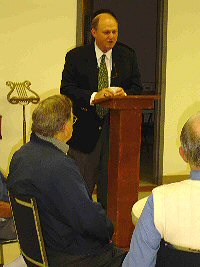 "Hurricane Ivan was a major event for the City of Foley and its planning," Foley City Administrator Perry Wilbourne reported to his January audience of "Men's 710 Second Tuesday," a men's monthly breakfast and speaker program at Zion Lutheran Church in beautiful Silverhill. "People were showing up needing help. The Chamber of Commerce was on the phone early in the aftermath. There were people with nothing left after the storm and there were no shelters." The shelter resources normally available were damaged by the storm and were just not there. What a problem! Foley is a busy place. All business buildings were occupied, space severely limited. Where can a city put a shelter when you have people waiting for services and no space available? Such were the problems facing the City of Foley after Ivan.
"Hurricane Ivan was a major event for the City of Foley and its planning," Foley City Administrator Perry Wilbourne reported to his January audience of "Men's 710 Second Tuesday," a men's monthly breakfast and speaker program at Zion Lutheran Church in beautiful Silverhill. "People were showing up needing help. The Chamber of Commerce was on the phone early in the aftermath. There were people with nothing left after the storm and there were no shelters." The shelter resources normally available were damaged by the storm and were just not there. What a problem! Foley is a busy place. All business buildings were occupied, space severely limited. Where can a city put a shelter when you have people waiting for services and no space available? Such were the problems facing the City of Foley after Ivan.
Thus emerged a theme in Wilbourne's presentation. "Response to a disaster is not so much a plan as it is a process." Recognize that Foley-Orange Beach-Gulf Shores is an economic unit for all practical purposes. When you have two-thirds of the unit disrupted, people flock to the remaining one-third. Foley had planned for disaster on one level. The community attempted to safeguard income flow by insuring sales tax revenue, but such insurance hinged on building destruction. The result was that since Foley was generally physically intact, its economics were what was compromised. Damage, yes, but income significantly down as well for the city at the very moment it needed resources to address post-hurricane needs like shelters, debris removal, transportation, infrastructure repair and replacement, and a host of other follow-up issues.
The city was forced into working from a continuing resolution position as opposed to a budget. When funds from tax revenues do not come in and the human needs are dire, a community must address needs. At this point in time, sales tax revenues are returning as Foley becomes a hub for goods and services for that Foley-Orange Beach-Gulf Shores economic unit. South Florida Consultant, Dr. Clay, has advised the group of cities that 70% of beach area condominiums will be up and running by March, resulting in a return of regular tourist trade for the area.
But, what about another Ivan or other natural disaster? What kinds of preparation can a city like Foley do? Wilbourne suggested that there is a need for federal involvement, planning, and funding to provide basic grants for identified needs resulting from the Hurricane Ivan aftermath. Power, for example, was a dilemma. The City of Foley now recognizes its need to develop a power generation capability for its central administration when its tie to the electrical grid is compromised by disaster. There is a need, for example, to develop buildings, which can withstand the strength of storms like Ivan, buildings that can readily be converted to shelters when needed. Foley learned about delay in emptying its business buildings to provide needed disaster support after Ivan. Logistics related to integrating the response of FEMA and others, argue for developing such buildings now.
Wilbourne fielded a number of questions from the 710 gathering. Older citizens had no place to go and no support system for getting out of the area when Lower Baldwin was evacuated for Ivan. Is there planning in place for such needs should another event like Ivan occur? The multiple use building development, Perry responded, is one response for this type of disaster relief, but there is a need for local governments to move to a higher level of building code oversight and incorporation of increased wind-load factors into new building codes. "There is general consensus that our buildings have to withstand these high winds." What about transportation within Baldwin? There is manpower already available and logistical support for reversing highways as was done on Interstate 65. This process can be applied to Highway 59 and the Foley Beach Express. And in terms of the Beach Express, it needs to be extended north. We need to talk to the Feds for funds to move people.